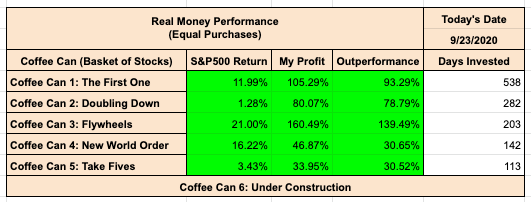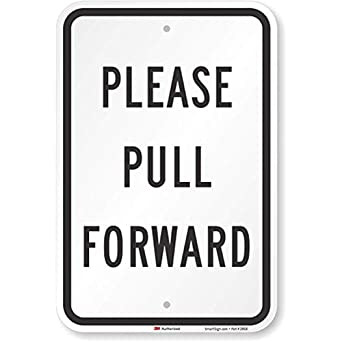What's in a Pull Forward?
Questions to be Asking
I am a big fan of the Coffee Can Portfolio, an “Active Passive” approach to investing. The idea is simple: You try to buy a basket of the best stocks you can and let them sit for years. You incur no costs with such a portfolio, and it is simple to manage. You can see the stocks in my Coffee Cans, and their performance here on my Scorecard.

Covid has created three types of businesses:
Businesses that are Booming
Businesses that are Suffering
Businesses that are somewhere in between
Where would you invest your money?
I think any of these three categories could prove to be good hunting grounds. But, to find a good investment candidate we need to evaluate three things:
How have the habits and behaviors of the business’ customers changed?
How will this change the usage and effectiveness of the company’s products or services?
How will the company respond to these changes?

The Booming Business
When it comes to businesses that have benefited from Covid, I tend to hear many people say “Covid has pulled forward years worth of demand.”
To invest in such a business, we must ask ourselves: What’s really in the pull forward?
Is the business growing because customers are learning about its products or services more quickly than they normally would have?
Or
Is the business simply replacing some real-world behavior that will revert back in normal times?
As investors, we must put ourselves in the shoes of the people running the business. Then we must try to get a read on what they will do. Sometimes they will tell us. Sometimes they won’t. But it is helpful to think about the challenges they face.
Let’s consider Zoom as an example.
I find it helpful to view businesses from the lens of the customer because they represent demand, and ask questions like the following:
What use-cases does Zoom cater to? eg: Zoom for Sales Meetings, Zoom for Casual Gaming, Zoom for Education etc
Of these, which cater to Zoom’s core audiences? Which ones are coincidental?
Which audiences should they be trying to keep vs let churn?
How likely are the new audiences to stay with Zoom post-Covid?
How are these new audiences using the product?
If they want to keep these new users, how can they improve the product for them?
These types of questions are important and need to be considered. But, as investors, we are not privy to the company’s internal data. Unfortunately, we may not be able to answer the above questions quantitatively. But at least thinking through these qualitatively will give us a much better sense of the challenges faced by the company.
Based on the answers (or lack thereof), we can better assess whether we’re willing to invest, and take on the risks faced by the business.
The Suffering Business
Here, we have the case where customer habits have been broken, and we need to think critically about what that means for the future of the business.
For example, if we were running the business, we can ask:
Which customers left?
Why did they leave?
Will these factors still apply post Covid? How about a few years post Covid?
Are there new alternatives that didn’t exist before?
We must ask how the business can rebuild the broken customer habits, and whether these habits will look the same or different than before?
If different, is that something the business can adjust to, and accommodate?
If yes, how difficult will this be?
Let’s consider Retailers as an example.
Retailers were badly hit during the pandemic. Answering the last question above, “can retailers rebuild broken shopping habits?”, is interesting. Perhaps foot-traffic will permanently decline going forward? Perhaps only outdoor/experiential/premium malls will survive? Perhaps things will go back to how they were; after all, eCommerce is not a new phenomenon? So we must ask, can retailers adjust and thrive in these potential futures?
Yesterday I saw an interesting set of tweets from Gavin Baker, which hints at a similar analysis. Gavin believes that omnichannel is the future. He believes category leading brick and mortar retailers are best positioned to deliver an omnichannel experience, and as a result, seems to be bullish on them going forward.



The In-Between Business
This is the third category. On the surface, such businesses seem ok. Top-line metrics like revenue or customer churn may look fine. But, as outside observers, it is difficult to discern what may be happening beneath the surface. For example, a SaaS customer who has already paid for an annual subscription will not have churned. But are they still a healthy customer? Will they renew next year? It’s hard to know.
So we must ask ourselves: who are the business’ customers, and what headwinds or tailwinds are they facing?
We must ask what could go wrong with the business, and what is the probability of those things happening? If they happen, will the business be in a position to mitigate the risks that emerge?
Answering these questions can be very tricky, especially without access to company-level data. As a result, the In-Between Businesses may be the hardest of the three types of businesses to invest in. Perhaps the best we can do is figure out what business metrics to monitor, and wait until we get some signal about whether the business is benefiting or hurting in a post-covid world. Of course, mis-pricing are typically found when there is uncertainty ahead, so there are pros and cons to this approach.
In Conclusion
Covid has created three types of businesses: businesses that are booming, suffering, or somewhere in between.
I think any of these three categories could prove to be good hunting grounds for a new investment. But, to find a good investment candidate, we require thoughtful evaluation.
It’s not enough simply to say “Covid has pulled forward years worth of demand” and therefore businesses benefiting from Covid will continue to do so. We must understand what’s really inside the pull forward.
For businesses that are suffering today, we have to think about how the business can rebuild the customer habits that have recently been broken, and how it can adjust to the changing needs of the customer.
And lastly, for businesses that seem to be somewhere in between, we must be careful. We must keep a close eye on what’s happening with the business’ customer base, and try to determine whether the business is slowly benefiting or hurting in a post-covid world.
Happy Investing!
Tell me if I missed anything…
And check out my Top Read Articles.
